The Impacts of Climate Variation and Land Use Changes on Streamflow in the Yihe River, China
Abstract
1. Introduction
2. Data collection and Analytical Methods
2.1. Study Area
2.2. Data Collection
2.3. Trend Test and Abrupt Point Detection for Hydroloclimatic Series
2.4. Attribution Analysis of Streamflow Variation
2.4.1. Budyko Analysis
2.4.2. Sensitivity Analysis
2.4.3. Quantification of Contribution
3. Results Analysis
3.1. Identification of the Breakpoint
3.2. Hydroclimatic Trend and Sensitivity of Streamflow to Environmental Factors
3.3. Quantitative Attribution Analysis of the Streamflow Decline
4. Discussion
4.1. Land Use Change and Its Impact on Streamflow Decline
4.2. The Impact of Climate Variation on Streamflow Change
4.3. Uncertainty of Quantitative Assessment and Future Research
5. Conclusions
- The trend analysis derived using Mann-Kendall tests indicated a significant downward trend in annual streamflow at the two stations. The abrupt point analyzed based on MKS and Pettitt’s test for the time series trend was detected in 1985.
- A reduction in P and an increase in PET was detected for two stations over most of the studied periods, except for in period I for PET. Land use change (w) increased in all the periods but without significance. The streamflow was found to be most sensitive to P, followed by PET and w for both periods and inter-annual change. The streamflow decline in Luhun was much more sensitive to the three variables than that in Dongwan.
- Climate change was the major contributor to streamflow alteration, which mainly comes from the increase in P and the decrease in PET, whose individual effects on streamflow change accounted for more than 50% and 20%, respectively. Land use change contributed to a small percentage of the change in streamflow at the two stations, which may be attributed to the small dynamic change of land use and less human interference in the study area.
- Although climate variation is substantially responsible for the streamflow change in the Yihe watershed, much attention should still be paid to land use management, since climate change is difficult to control and streamflow can be regulated through artificial measures (such as reforestation and re-grassing) to promote sustainable development of water resources.
- The variation in streamflow at various time scales (such as monthly and seasonal scales) is also very important for water resource planning and management. More attempts should be made to achieve this in future studies, for example by applying a hydrologic model (such as SWAT) to investigate the changes in streamflow at monthly scale.
Author Contributions
Funding
Acknowledgments
Conflicts of Interest
Appendix A
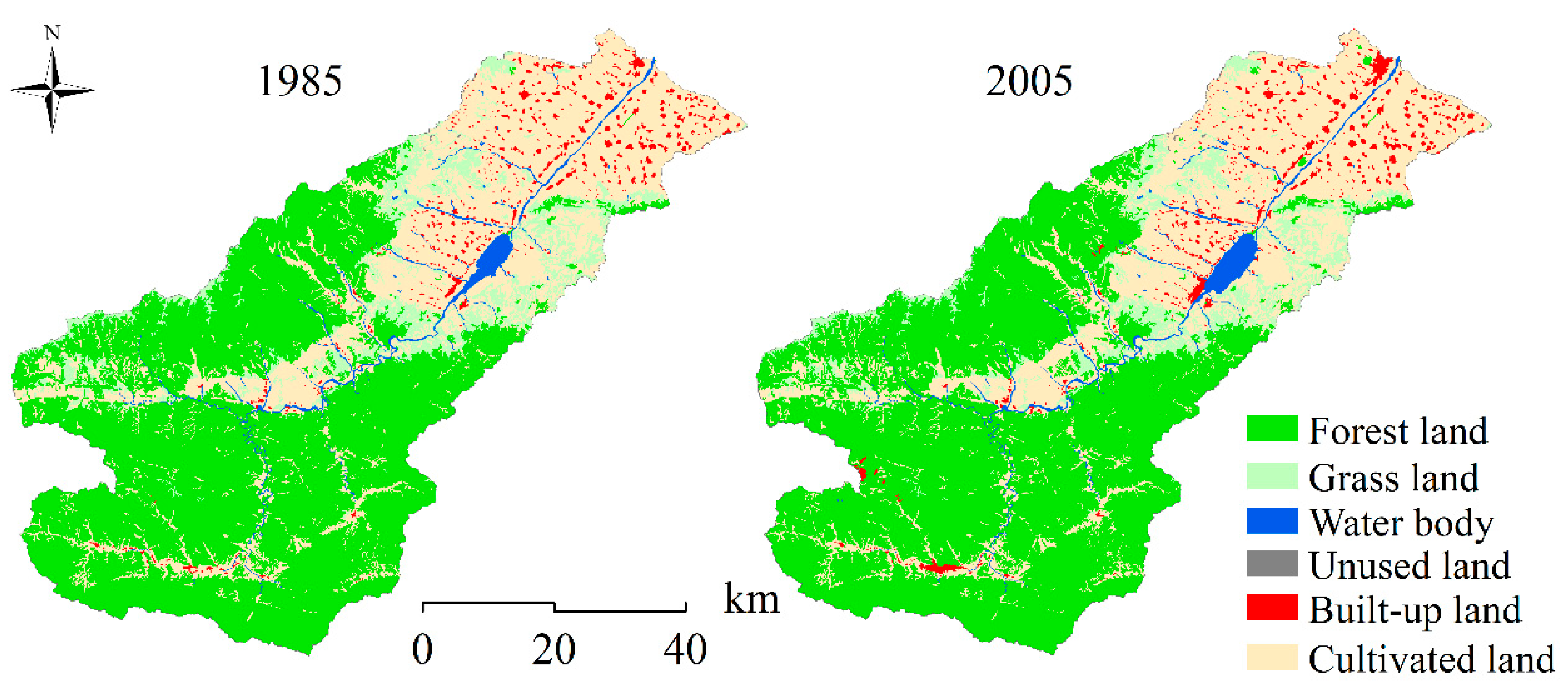
References
- Oki, T. Global hydrological cycles and world water resources. Science 2006, 313, 1068–1072. [Google Scholar] [CrossRef]
- Sherwood, S.; Fu, Q. A drier future? Science 2014, 343, 737–739. [Google Scholar] [CrossRef]
- Labat, D.; Goddéris, Y.; Probst, J.L.; Guyot, L.J. Evidence for global runoff increase related to climate warming. Adv. Water Resour. 2004, 27, 631–642. [Google Scholar] [CrossRef]
- Carlos, E.; Pedro, N. Meteorological drought features in northern and northwestern parts of Mexico under different climate change scenarios. J. Arid Land 2017, 9, 68–78. [Google Scholar] [CrossRef]
- Karabulut, M. Drought analysis in Antakya-Kahramanmara? Graben, Turkey. J. Arid Land 2015, 7, 741–754. [Google Scholar] [CrossRef]
- Vicente-Serrano, S.M.; López-Moreno, J.I.; Beguería, S.; Lorenzo-Lacruz, J. Evidence of increasing drought severity caused by temperature rise in southern Europe. Environ. Res. Lett. 2014, 9, 1–9. [Google Scholar] [CrossRef]
- Liu, X.P.; Li, X.; Shi, X.; Wu, S.K. Simulating complex urban development using kernel-based non-linear cellular automata. Ecol. Model. 2008, 211, 169–181. [Google Scholar] [CrossRef]
- Sterling, S.M.; Ducharne, A.; Polcher, J. The impact of global land-cover change on the terrestrial water cycle. Nat. Clim. Chang. 2012, 3, 385–390. [Google Scholar] [CrossRef]
- Stone, R. Saving Iran’s great salt lake. Science 2015, 349, 1044–1047. [Google Scholar] [CrossRef]
- Wurtsbaugh, W.A.; Miller, C.; Null, S.E.; DeRose, J.; Wilcock, P.; Hahnenberger, M.; Howe, F.; Moore, J. Decline of the world’s saline lakes. Nat Geosci. 2017, 10, 816–821. [Google Scholar] [CrossRef]
- Pokhrel, Y.; Hanasaki, N.; Koirala, S.; Cho, J. Incorporating anthropogenic water regulation modules into a land surface model. J. Hydrometeorol. 2017, 13, 255–269. [Google Scholar] [CrossRef]
- AghaKouchak, A.; Norouzi, H.; Madani, K.; Mirchi, A.; Azarderakhsh, M.; Nazemi, A.; Nasrollahi, N.; Farahmand, A.; Mehran, A.; Hasanzadeh, E. Aral Sea syndrome desiccates Lake Urmia: Call for action. J. Great Lakes Res. 2015, 41, 307–311. [Google Scholar] [CrossRef]
- Tan, C.; Ma, M.; Kuang, H. Spatial-temporal characteristics and climatic responses of water level fluctuations of global major lakes from 2002 to 2010. Remote Sens. 2017, 9, 150. [Google Scholar] [CrossRef]
- Lee, S.; Kim, S.U. Quantification of hydrological responses due to climate change and human activities over various ttime scales in South Korea. Water 2017, 9, 34. [Google Scholar] [CrossRef]
- Kim, S.U.; Y, X. Analysis of dam inflow variation using the hydrological sensitivity method in a trans-boundary river basin: Case study in the Korean Peninsula. Water 2019, 11, 395. [Google Scholar] [CrossRef]
- Mao, T.; Wang, G.; Zhang, T. Impacts of climatic change on hydrological regime in the Three-River Headwaters Region, China, 1960–2009. Water Resour. Manag. 2016, 30, 115–131. [Google Scholar] [CrossRef]
- Middelkoop, H.; Daamen, K.; Gellens, D.; Grabs, W.; Kwadijk, J.C.; Lang, H.; Parmet, B.W.; Schädler, B.; Schulla, J.; Wilke, K. Impact of climate change on hydrological regimes and water resources management in the Rhine Basin. Clim. Chang. 2001, 49, 105–128. [Google Scholar] [CrossRef]
- Chaemiso, S.E.; Abebe, A.; Pingale, S.M. Assessment of the impact of climate change on surface hydrological processes using SWAT: A case study of Omo-Gibe river basin, Ethiopia. Model. Earth Syst Environ. 2016, 2, 1–15. [Google Scholar] [CrossRef]
- Ghaffari, G.; Keesstra, S.D.; Ghoddousi, J.; Ahmadi, H. SWAT-simulated hydrological impact of land-use change in the Zanjanrood basin, Northwest Iran. Hydrol. Process. 2010, 24, 892–903. [Google Scholar] [CrossRef]
- Gashaw, T.; Tulu, T.; Argaw, M.; Worqlul, A.W. Modeling the hydrological impacts of land use/land cover changes in the Andassa watershed, Blue Nile Basin, Ethiopia. Sci. Total Environ. 2018, 619, 1394–1408. [Google Scholar] [CrossRef]
- Nunes, A.N.; Almeida, A.C.; Coelho, C. Impact of land use and cover type on runoff and soil erosion in a marginal area of Portugal. Appl. Geogr. 2011, 31, 687–699. [Google Scholar] [CrossRef]
- Huang, M.; Zhang, L.; Gallichand, J. Runoff responses to afforestation in a watershed of the Loess Plateau, China. Hydrol. Process. 2003, 17, 2599–2609. [Google Scholar] [CrossRef]
- Arrigoni, A.S.; Greenwood, M.C.; Moore, J.N. Relative impact of anthropogenic modifications versus climate change on the natural flow regimes of river in the Northern Rocky Mountains, United States. Water Resour. Res. 2010, 46, W12542. [Google Scholar] [CrossRef]
- Vogel, R.M.; Yaindl, C.; Walter, M. Nonstationarity: Flood magnification and recurrence reduction factors in the United States. J. Am. Water. Resour. Assoc. 2011, 47, 464–474. [Google Scholar] [CrossRef]
- Wang, S.; Kang, S.; Zhang, L.; Li, F.S. Modelling hydrological response to different land-use and climate change scenarios in the Zamu River Basin of Northwest China. Hydrol. Process. 2008, 22, 2502–2510. [Google Scholar] [CrossRef]
- Lafontaine, J.H.; Hay, L.E.; Viger, R.J.; Regan, R.S. Effects of climate and land cover on hydrology in the Southeastern U.S.: Potential impacts on watershed planning. J. Am. Water. Resour. Assoc. 2015, 51, 1235–1261. [Google Scholar] [CrossRef]
- Vaighan, A.A.; Talebbeydokhti, N.; Bavani, A.M. Assessing the impacts of climate and land use change on streamflow, water quality and suspended sediment in the Kor River Basin, Southwest of Iran. Environ. Earth Sci. 2017, 76, 543–560. [Google Scholar] [CrossRef]
- Karim, F.; Petheram, C.; Marvanek, S.; Ticehurst, C. Impact of climate change on floodplain inundation and hydrological connectivity between wetlands and rivers in a tropical river catchment. Hydrol. Process. 2016, 30, 1574–1593. [Google Scholar] [CrossRef]
- Budyko, M.I. Climate and Life; Academic: New York, NY, USA, 1974; 508p. [Google Scholar]
- Zhang, C.Q.; Zhang, B.; Li, W.H.; Liu, M.C. Response of streamflow to climate change and human activity in Xitiaoxi river basin in China. Hydrol Process. 2014, 28, 43–50. [Google Scholar] [CrossRef]
- Gao, G.Y.; Fu, B.J.; Wang, S.; Liang, W.; Jiang, X.H. Determining the hydrological responses to climate variability and land use/cover change in the Loess Plateau with the Budyko framework. Sci. Total Environ. 2016, 557, 331–342. [Google Scholar] [CrossRef]
- Xu, X.; Yang, D.; Yang, H. Attribution analysis based on the Budyko hypothesis for detecting the dominant cause of runoff decline in Haihe basin. J. Hydrol. 2014, 510, 530–540. [Google Scholar] [CrossRef]
- Zhao, Y.; Zhang, X.M.; Cao, W.C.; Yu, X.X.; Liu, B.; Zhu, B.S.; Cheng, C.; Yin, X.L.; Xie, G. Effect of climatic change and afforestation on water yield in the Rocky Mountain Area of North China. For. Syst. 2015, 24, 1–9. [Google Scholar] [CrossRef]
- Yuan, Y.J.; Zhang, C.; Zeng, G.M.; Liang, J.; Guo, S.L.; Huang, L.; Wu, H.P.; Hua, S.S. Quantitative assessment of the contribution of climate variability and human activity to streamflow alteration in Dongting Lake, China. Hydrol. Process. 2016, 30, 1929–1939. [Google Scholar] [CrossRef]
- Stonestrom, D.A.; Scanlon, B.R.; Zhang, L. Introduction to special section on Impacts of Land Use Change on Water Resources. Water Resour. Res. 2009, 45, 160–169. [Google Scholar] [CrossRef]
- Napoli, M.; Massetti, L.; Orlandini, S. Hydrological response to land use and climate changes in a rural hilly basin in Italy. Catena 2017, 157, 1–11. [Google Scholar] [CrossRef]
- Guimberteau, M.; Ronchail, J.; Espinoza, J.C.; Lengaigne, M.; Sultan, B.; Polcher, J.; Drapeau, G.; Guyot, J.L.; Ducharne, A.; Ciais, P. Future changes in precipitation and impacts on extreme streamflow over Amazonian sub-basins. Environ. Res. Lett. 2013, 8, 1–13. [Google Scholar] [CrossRef]
- Dai, S.B.; Lu, X.X.; Yang, S.L. A preliminary estimate of human and natural contributions to the decline in sediment flux from the Yangtze River to the East China Sea. Quat. Int. 2008, 186, 43–54. [Google Scholar] [CrossRef]
- Zhao, G.J.; Tian, P.; Mu, X.M.; Jiao, J.Y.; Wang, F.; Gao, P. Quantifying the impact of climate variability and human activities on streamflow in the middle reaches of the Yellow River basin, China. J. Hydrol. 2014, 519, 387–398. [Google Scholar] [CrossRef]
- He, Y.; Wang, F.; Mu, X.; Guo, L.Q. Human activity and climate variability impacts on sediment discharge and runoff in the Yellow River of China. Theor. Appl. Climatol. 2016, 129, 1–10. [Google Scholar] [CrossRef]
- Jiang, C.; Xiong, L.H.; Wang, D.B.; Liu, P. Separating the impacts of climate change and human activities on runoff using the Budyko-type equations with time-varying parameters. J. Hydrol. 2015, 522, 326–338. [Google Scholar] [CrossRef]
- Bai, P.; Liu, W.H.; Guo, M.J. Impacts of climate variability and human activities on decrease in streamflow in the Qinhe River, China. Theor. Appl. Climatol. 2014, 117, 293–301. [Google Scholar] [CrossRef]
- Xu, J. Variation in annual runoff of the Wudinghe River as influenced by climate change and human activity. Quat. Int. 2011, 244, 230–237. [Google Scholar] [CrossRef]
- Tian, L. The Simulation of Landscape Pattern in Yihe River Basin—A Case Study of Luanchuan County; Henan University: Kaifeng, China, 2010. [Google Scholar] [CrossRef]
- Zhang, J.J.; Gao, Y.B.; Xue, Y. Analysis of characteristics of climate change over last 46 years in Luoyang. Meteorol. Environ. Sci. 2008, 31, 138–141. [Google Scholar] [CrossRef]
- Zhao, X.F.; Zhang, M.Q. The ecosystem that the mineral development of LuoYang result in break and counterplan. J. Henan For. Sci. Technol. 2005, 25, 23–24. (In Chinese) [Google Scholar]
- Ren, J.Y.; Liu, H.M.; Ding, S.Y.; Wang, M.N.; Bian, Z.Q. Landscape pattern change and its driving mechanism in Yihe River basin, China. J. Appl. Ecol. 2017, 28, 2611–2620. [Google Scholar] [CrossRef]
- Du, F. The Response of Hydrological Effect to Land Use/Land Cover Change in the Yiluohe Basin; HohaiUniversity: Nanjing, China, 2007. [Google Scholar] [CrossRef]
- Allen, R.G.; Pereira, L.S.; Raes, D.; Smith, M. Crop Evapotranspiration—Guidelines for Computing Crop Water Requirements; FAO Irrigation and Drainage Paper 56; Food and Agriculture Organization of the United Nations: Rome, Italy, 1998; p. 300. [Google Scholar]
- Tegos, A.; Malamos, N.; Koutsoyiannis, D. A parsimonious regional parametric evapotranspiration model based on a simplification of the Penman-Monteith formula. J. Hydrol. 2015, 524, 708–717. [Google Scholar] [CrossRef]
- Mann, H.B. Nonparametric tests against trend. Econometrica 1945, 13, 245–259. [Google Scholar] [CrossRef]
- Kendall, M.G. Rank Correlation Measures; Charles Griffin: London, UK, 1975. [Google Scholar]
- Wu, L.H.; Wang, S.J.; Bai, X.Y.; Luo, W.J.; Tian, Y.C.; Zeng, C.; Luo, G.J.; He, S.Y. Quantitative assessment of the impacts of climate change and human activities on runoff change in a typical karst watershed, SW China. Sci. Total Environ. 2017, 601–602, 1449–1465. [Google Scholar] [CrossRef]
- Sneyers, R. Sur L’analyse Statistique des Séries D’observations; Tech. Note, 194; WMO: Geneva, Switzerland, 1975; pp. 9–12. [Google Scholar]
- Mwangi, H.M.; Julich, S.; Patil, S.D.; McDonald, M.A.; Feger, K.H. Relative contribution of land use change and climate variability on discharge of upper Mara River, Kenya. J. Hydrol. Reg. Stud. 2016, 5, 244–260. [Google Scholar] [CrossRef]
- Zhang, Y.; Guan, D.; Jin, C.; Wang, A.Z. Impacts of climate change and land use change on runoff of forest catchment in northeast China. Hydrol. Process. 2014, 28, 186–196. [Google Scholar] [CrossRef]
- Chen, Z.; Chen, Y.; Li, B. Quantifying the effects of climate variability and human activities on runoff for Kaidu River Basin in arid region of northwest China. Theor. Appl. Climatol. 2013, 111, 537–545. [Google Scholar] [CrossRef]
- Ning, T.; Li, Z.; Liu, W. Separating the impacts of climate change and land surface alteration on runoff reduction in the Jing River catchment of China. Catena 2016, 147, 80–86. [Google Scholar] [CrossRef]
- Yang, D.; Zhang, S.; Xu, X. Attribution analysis for runoff decline in Yellow River Basin during past fifty years based on Budyko hypothesis (in Chinse). Sci. Sin. Technol. 2015, 45, 1024–1034. [Google Scholar] [CrossRef]
- Wu, J.W.; Miao, C.Y.; Wang, Y.M.; Duan, Q.Y.; Zhang, X.M. Contribution analysis of the long-term changes in seasonal runoff on the Loess Plateau, China, using eight Budyko-based methods. J. Hydrol. 2017, 545, 263–275. [Google Scholar] [CrossRef]
- Li, F.P.; Zhang, G.X.; Yi, X. Separating the impacts of climate variation and human activities on runoff in the Songhua River basin, Northeast China. Water 2014, 6, 3320–3338. [Google Scholar] [CrossRef]
- Liang, G.F. landscape Pattern and Runoff Change in Yilhe Basin—A Case Study of the Upper Reaches; Henan University: Kaifeng, China, 2010. [Google Scholar] [CrossRef]
- Yin, Z.; Feng, Q.; Yang, L.; Wen, X.; Si, J.; Zou, S. Long term quantification of climate and land cover change impacts on streamflow in an Alpine River Catchment, northwestern China. Sustainability 2017, 9, 1278. [Google Scholar] [CrossRef]
- Piao, S.L.; Ciais, P.; Huang, Y.; Shen, Z.H.; Peng, S.S.; Li, J.S. The impacts of climate change on water resources and agriculture in China. Nature 2010, 467, 43–51. [Google Scholar] [CrossRef]
- Lan, K.; Hong, L. Analysis to runoff evolution features along time series in karst drainage basin—A case study in Guizhou province. Carsologica Sin. 2007, 26, 341–346. [Google Scholar] [CrossRef]
- Jencso, K.; Mcglynn, B.L. Hierarchical controls on runoff generation: Topographically driven hydrologic connectivity, geology, and vegetation. Water Resour. Res. 2011, 47, 431–435. [Google Scholar] [CrossRef]
- Ru, H.; Lin, H.; He, B.H. Effects of slope forest and grass vegetation on reducing rainfall-runoff erosivity in Three Gorges Reservoir Region. Trans. Chin. Soc. Agric. Eng. 2012, 28, 70–76. [Google Scholar] [CrossRef]
- El-Kateb, H.; Zhang, H.; Zhang, P. Soil erosion and surface runoff on different vegetation covers and slope gradients: A field experiment in Southern Shaanxi Province, China. Catena 2013, 105, 1–10. [Google Scholar] [CrossRef]
- Li, Q.Y.; Sun, Y.W.; Yuan, W.L.; Lyu, S.B.; Wan, F. Streamflow responses to climate change and LUCC in a semi-arid watershed of Chinese Loess Plateau. J. Arid Land 2017, 4, 139–151. [Google Scholar] [CrossRef][Green Version]
- Han, Y.N.; Niu, J.Z.; Xin, Z.B.; Wei, Z. Optimization of land use pattern reduces surface runoff and sediment loss in a Hilly-Gully Watershed at the Loess Plateau, China. For. Syst. 2016, 25, 1–14. [Google Scholar] [CrossRef]
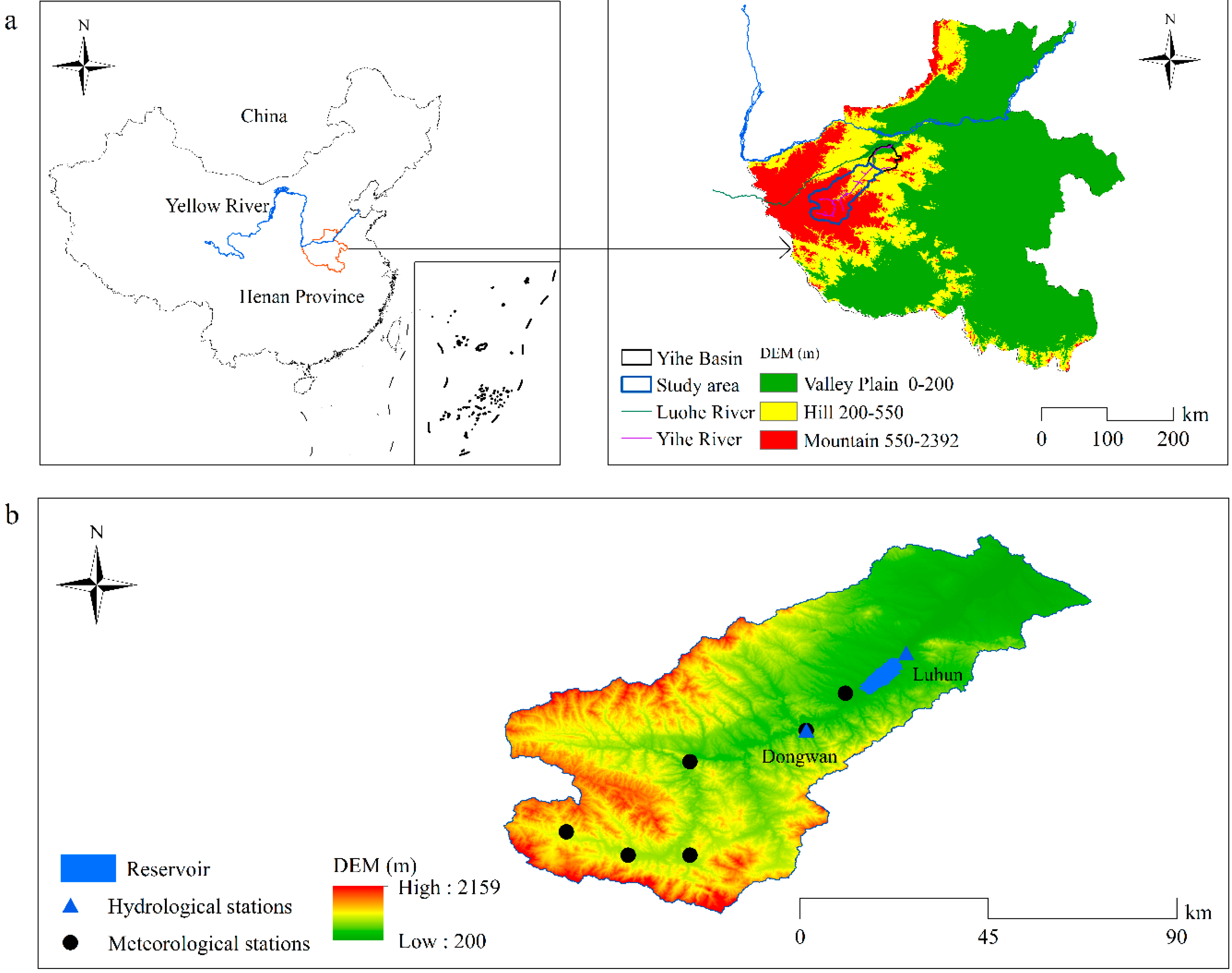
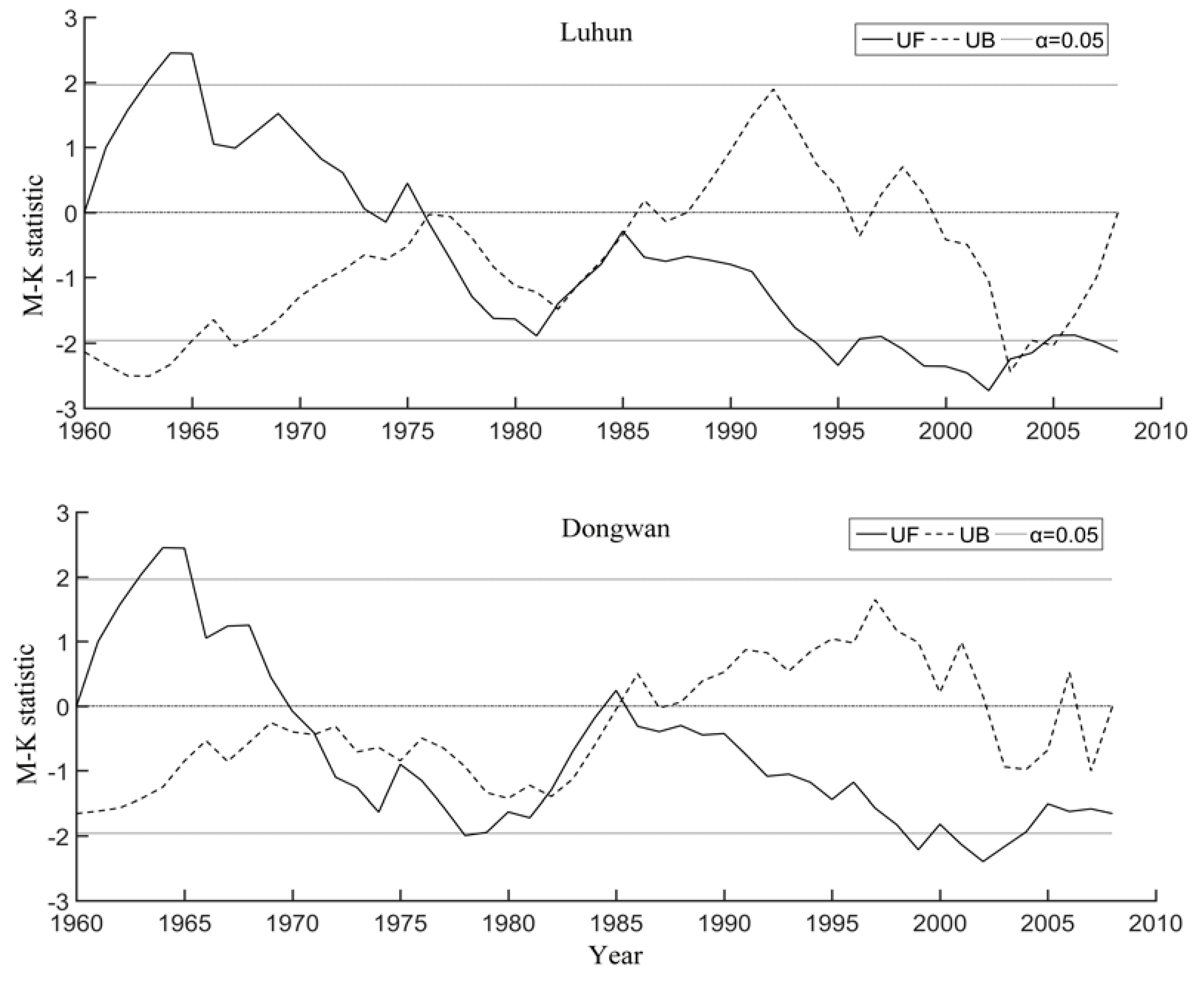
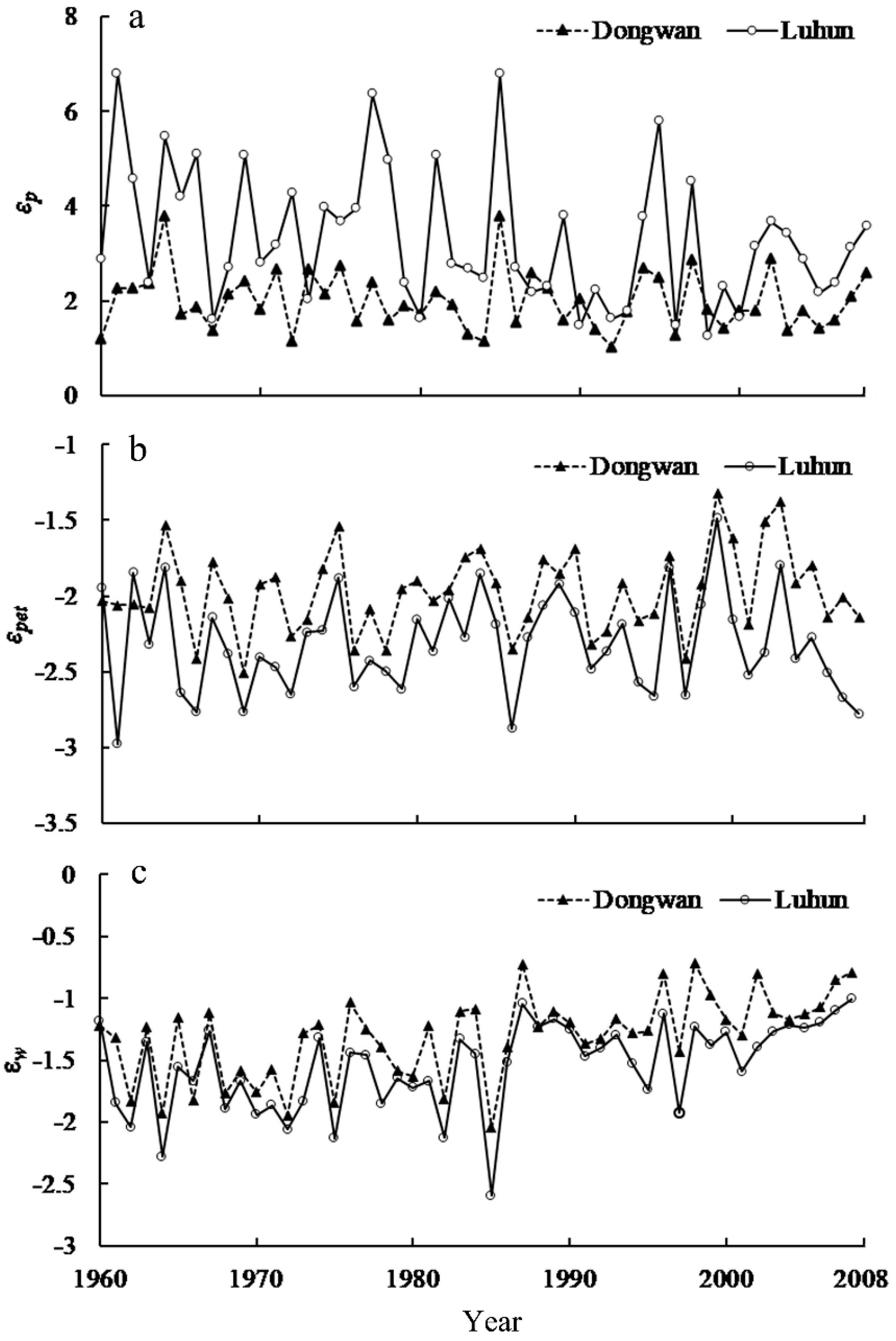
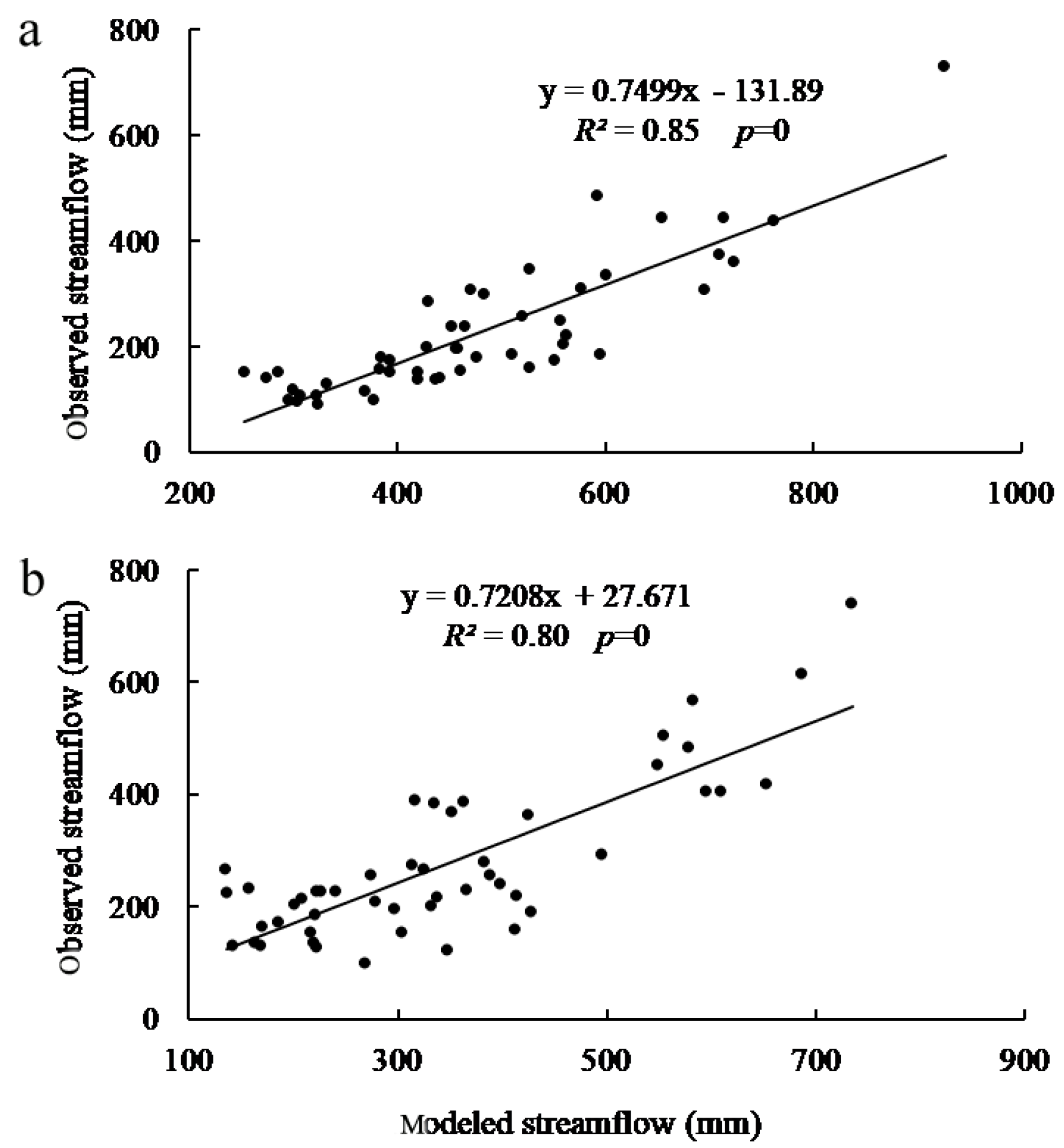
| Stations | p-Value | Decision |
|---|---|---|
| Luhun | 0.02 | Change point: 1985 |
| Dongwan | 0.04 | Change point: 1985 |
| Period | Stations | Q (mm) | P (mm) | PET (mm) | w | Sensitivity Coefficient | ||||||||||
|---|---|---|---|---|---|---|---|---|---|---|---|---|---|---|---|---|
| Average | Z | β | Average | Z | β | Average | Z | β | Average | Z | β | εp | εpet | εw | ||
| Whole period | DW | 125.39 | −1.77 ** | −0.17 | 837.03 | −0.25 | −0.23 | 420.53 | 1.54 * | 0.05 | 2.01 | 0.69 | 0.005 | 1.89 | −1.65 | −1.23 |
| LH | 150.94 | −1.97 ** | −0.21 | 712.35 | −0.68 | −1.39 | 441.37 | 0.13 | 0.59 | 2.14 | 1.18 | 0.02 | 3.22 | −1.53 | −1.42 | |
| Period I | DW | 144.15 | 0.22 | 0.05 | 861.97 | −0.48 | −0.21 | 420.10 | −1.7 2 ** | −1.09 | 1.96 | −0.75 | -0.01 | 2.23 | −2.02 | −1.68 |
| LH | 176.64 | −0.26 | −0.03 | 718.04 | −0.26 | −0.20 | 450.04 | −2.95 ** | −3.16 | 2.16 | −1.45 | -0.05 | 3.87 | −2.34 | −1.01 | |
| Period II | DW | 104.21 | −0.48 | −0.06 | 808.83 | −1.74 ** | −0.71 | 401.01 | 1.69 ** | 1.31 | 2.08 | 0.05 | 0.002 | 1.95 | −2.07 | −0.74 |
| LH | 121.89 | −0.16 | −0.07 | 703.31 | 0 | −0.03 | 431.58 | 3.59 *** | 4.52 | 2.13 | 1.06 | 0.05 | 3.91 | −2.36 | −1.43 | |
| Stations | Difference between ΔQ and ΔQ’ from Period I to Period II | P/PET/Land Use Change Induced Streamflow Change (mm) | Contribution to Streamflow Change (%) | ||||||
|---|---|---|---|---|---|---|---|---|---|
| ΔQ | ΔQ’ | Δ | ΔQp | ΔQpet | ΔQw | ηp | ηpet | ηw | |
| Dongwan | −55.53 | −56.55 | 1.02 | −27.91 | −13.53 | −14.09 | 50.01 | 24.25 | 25.25 |
| Luhun | −72.65 | −72.88 | 0.23 | −40.22 | −17.76 | −14.67 | 55.36 | 24.45 | 20.19 |
| Land Use Type | Area (km2) | Percentage (%) | ||
|---|---|---|---|---|
| 1985 | 2005 | 1985 | 2005 | |
| Cultivated land | 1514.82 | 1503.17 | 32.56 | 32.31 |
| Forest land | 2568.39 | 2588.63 | 55.20 | 55.64 |
| Grass land | 389.01 | 350.73 | 8.36 | 7.54 |
| Water body | 87.38 | 95.63 | 1.88 | 2.056 |
| Built-up land | 94.24 | 116.57 | 2.03 | 2.51 |
| Unused land | 0.66 | 0.83 | 0.01 | 0.02 |
| Land Use Type | 2005 | ||||||
|---|---|---|---|---|---|---|---|
| Cultivated Land | Forest Land | Grass Land | Water Body | Built-Up Land | Unused Land | ||
| 1985 | Cultivated land | 1479.61 | 5.85 | 0 | 10.71 | 18.59 | 0.06 |
| Forest land | 0.81 | 2563.87 | 0 | 0.13 | 3.59 | 0 | |
| Grass land | 22.09 | 15.92 | 350.73 | 0 | 0.16 | 0.10 | |
| Water body | 0.65 | 0 | 0 | 84.78 | 0 | 0 | |
| Built-up land | 0 | 0 | 0 | 0 | 94.24 | 0 | |
| Unused land | 0 | 0 | 0 | 0 | 0 | 0.67 | |
| Period | Contribution of Different Land Use Types to Streamflow Decline/% | |||
|---|---|---|---|---|
| Cultivated Land | Forest Land | Grass Land | Built-Up Land | |
| Period I | 15.55 | 40.96 | 20.43 | 13.06 |
| Period II | 15.40 | 38.41 | 34.74 | 11.43 |
© 2019 by the authors. Licensee MDPI, Basel, Switzerland. This article is an open access article distributed under the terms and conditions of the Creative Commons Attribution (CC BY) license (http://creativecommons.org/licenses/by/4.0/).
Share and Cite
Xu, S.; Qin, M.; Ding, S.; Zhao, Q.; Liu, H.; Li, C.; Yang, X.; Li, Y.; Yang, J.; Ji, X. The Impacts of Climate Variation and Land Use Changes on Streamflow in the Yihe River, China. Water 2019, 11, 887. https://doi.org/10.3390/w11050887
Xu S, Qin M, Ding S, Zhao Q, Liu H, Li C, Yang X, Li Y, Yang J, Ji X. The Impacts of Climate Variation and Land Use Changes on Streamflow in the Yihe River, China. Water. 2019; 11(5):887. https://doi.org/10.3390/w11050887
Chicago/Turabian StyleXu, Shanshan, Mingzhou Qin, Shengyan Ding, Qinghe Zhao, Huimin Liu, Cangyu Li, Xiaojie Yang, Yanyan Li, Jiaxin Yang, and Xiaoyu Ji. 2019. "The Impacts of Climate Variation and Land Use Changes on Streamflow in the Yihe River, China" Water 11, no. 5: 887. https://doi.org/10.3390/w11050887
APA StyleXu, S., Qin, M., Ding, S., Zhao, Q., Liu, H., Li, C., Yang, X., Li, Y., Yang, J., & Ji, X. (2019). The Impacts of Climate Variation and Land Use Changes on Streamflow in the Yihe River, China. Water, 11(5), 887. https://doi.org/10.3390/w11050887




